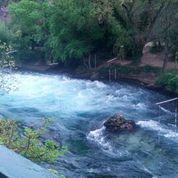We flew into Paris, but as we had both been there several times before we decided to spend most of our time elsewhere. Our first stop was in the Loire Valley, about an hour outside of Tours. We stayed at a small renovated chateau owned by a very nice British-French family.
In the five years they have owned the property they have completely renovated the main floors, established a flock of sheep, a goat, a donkey, five chickens, and four of their own children. They also have one field planted, a kitchen garden, a small orchard, and a swimming pool. In addition they have a full-time chef who prepares breakfast and dinner for the guests every day. Needless to say, it was a wonderful place to be!
The Loire Valley is known for its large amount of chateaus. Being relatively close to Paris, French noblemen and royalty built palaces for themselves out in the countryside for hunting and summer homes. The one we stayed at was relatively small, but we visited another that is the most elaborate of them all, Chenonceau.
The chateau was originally build in the 11th century and, as you can see, was built over a small river.
Even though it was still very early spring in France, the gardens were absolutely beautiful.
Knowing that it can be rather cool in France still at the end of April, we chose to spend the majority of our time in Provence where it is always warm and sunny. We stayed in Avignon and planned several day trips to see the surrounding countryside, Provencal villages, and the local Roman ruins. What we didn't plan on was climate change. Instead of the warm and sunny Provence that had been advertised we experienced temperatures from the upper 30s to a high in the mid-50s. In addition there was more rain than the locals had seen in 20 years! Our lovely tour guide, Michelle, felt so sorry for me and my Egyptian wardrobe that she loaned me her down jacket for two days. Nevertheless, we very much enjoyed Provence.
Avignon is famous for two things- its bridge and its brief stint as the home of the Roman Catholic pope. The bridge has been mostly destroyed by floods, but there is one section still standing.
We were lucky to have Michelle as a tour guide for two full days. On the first day she took us around to some of the more famous villages in Provence. We got to see a market in Carpentras (I bought some shoes, John got olives) and a town called Roussillon, which means Red Village. There is a red tint to the earth in the area which the locals use to paint all their buildings.
One of the other memorable towns was Fontaine-de-Vaucluse, located in the Vaucluse Mountains of Provence. Just outside the town is a spring that looks perfectly calm:
Our second day out with Michelle we went to see the Pont du Gard. This is part of a 130km long aqueduct built by the Romans. Most of the aqueduct is underground, and large parts of it are no longer intact. The Pont du Gard, however, has been very well preserved. It was raining quite steadily during our visit, but we did get a few pictures:
The part of the bridge that people can walk across is actually a second bridge that was built in the mid-1800s. It exactly parallels the old bridge so it doesn't distort the view from a distance, but it does protect the old stones from more wear and tear.
After seeing this bridge the rain picked up and we couldn't get any more pictures. We spent the rest of our time practicing French (my husband is getting really good!) and relaxing. It was very nice to spend some time in the developed world, and a bit of a challenge to come back to the craziness of Egypt. But we have less than three months left!















No comments:
Post a Comment
Note: Only a member of this blog may post a comment.